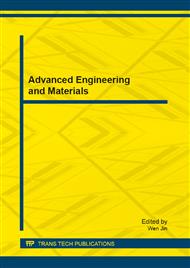[1]
J. M. White, E. Siegfried, M. Boulden, G. Padda, Possible hazards of cryogen use with pulsed dye laser-A case report and summary, Dermatol. Surg. 25 (1999) 250-252.
DOI: 10.1046/j.1524-4725.1999.08198.x
Google Scholar
[2]
L. W. Man, P. Kumar, T. T. Teng, K. L. Wasewar, Comparison of electro-coagulation using iron and aluminium electrodes with chemical coagulation for the removal of a highly soluble acid dye, Desalin. Water Treat. 40 (2012) 260-271.
DOI: 10.5004/dwt.2012.3072
Google Scholar
[3]
G. M. Nisola, E. Cho, A. B. Beltran, M. Han, Y. Kim, W. J. Chung, Dye/water separation through supported liquid membrane extraction, Chemosphere 80 (2010) 894-900.
DOI: 10.1016/j.chemosphere.2010.05.003
Google Scholar
[4]
J. Lebek, W. Wardas, Adsorption of some textile dyes on post-vanillin lignin during its precipitation, Cell Chem. Technol. 30 (1996) 213-221.
Google Scholar
[5]
N. Uzal, L. Yilmaz, U. Yetis, Microfiltration: a pretreatment alternative for indigo dyeing textile wastewater, Desalination 199 (2006) 515-517.
DOI: 10.1016/j.desal.2006.03.116
Google Scholar
[6]
N. F. Cardoso, R. B. Pinto, E. C. Lima, T. Calvete, C. V. Amavisca, B. Royer, M. L. Cunha, T. H. M. Fernandes, I. S. Pinto, Removal of remazol black B textile dye from aqueous solution by adsorption, Desalination 269 (2011) 92-103.
DOI: 10.1016/j.desal.2010.10.047
Google Scholar
[7]
H. A. Abd El-Rehim, E. S. A. Hegazy, D. A. Diaa, Photo-catalytic degradation of Metanil Yellow dye using TiO2 immobilized into polyvinyl alcohol/acrylic acid microgels prepared by ionizing radiation, React. Funct. Polym. 72 (2012) 823-831.
DOI: 10.1016/j.reactfunctpolym.2012.07.009
Google Scholar
[8]
W. S. Hummers, R. E. Offeman, Preparation of graphitic oxide, J. Am. Chem. Soc. 80 (1958) 1339-1339.
DOI: 10.1021/ja01539a017
Google Scholar
[9]
I. Langmuir, Chemical reactions at very low pressures. I. The clean-up of oxygen in a tungsten lamp, J. Am. Chem. Soc. 35 (1913) 105-127.
DOI: 10.1021/ja02191a001
Google Scholar
[10]
H. Freundlich, W. Heller, The Adsorption of cis- and trans-Azobenzene, J. Am. Chem. Soc. 61 (1939) 2228-2230.
DOI: 10.1021/ja01877a071
Google Scholar
[11]
S. Liu, J. Tian, L. Wang, Y. Zhang, Y. Luo, A. M. Asiri, A. O. Al-Youbi, X. Sun, A novel acid-driven, microwave-assisted, one-pot strategy toward rapid production of graphitic N-doped car bon nanoparticles-decorated carbon flakes from N , N -dimethylformamide and their application in removal of dye from water, RSC Adv. 2 (2012).
DOI: 10.1039/c2ra20381b
Google Scholar
[12]
G. K. Ramesha, A. V. Kumara, H. B. Muralidhara, S. Sampath, Graphene and graphene oxide as effective adsorbents toward anionic and cationic dyes, J. Colloid Interf. Sci. 361(2011) 270-277.
DOI: 10.1016/j.jcis.2011.05.050
Google Scholar
[13]
Z. G. Geng, Y. Lin, X. X. Yu, Q. H. Shen, L. Ma, Z. Y. Li, N. Pan, X. P. Wang, Highly Efficient Dye Adsorption and Removal: Functional Hybrid of Reduced Graphene Oxide−Fe3O4 Nanoparticles as An Easily Regenerative Adsorbent, J. Mater. Chem. 22 (2012).
DOI: 10.1039/c2jm15544c
Google Scholar
[14]
H. M. Sun, L. Y. Cao, L. H. Lu, Magnetite/Reduced Graphene Oxide Nanocomposites: One Step Solvothermal Synthesis and Use as a Novel Platform for Removal of Dye Pollutants, Nano Res. 4 (2011) 550-562.
DOI: 10.1007/s12274-011-0111-3
Google Scholar



